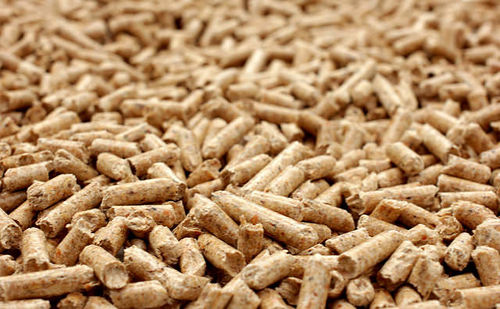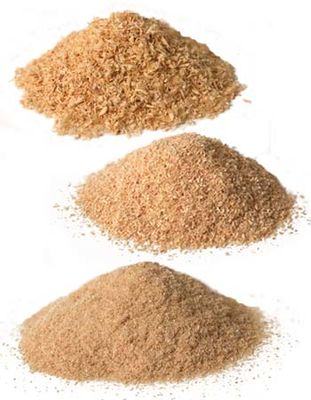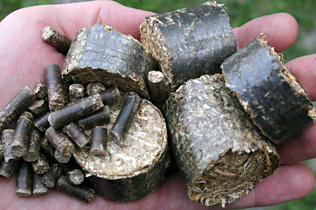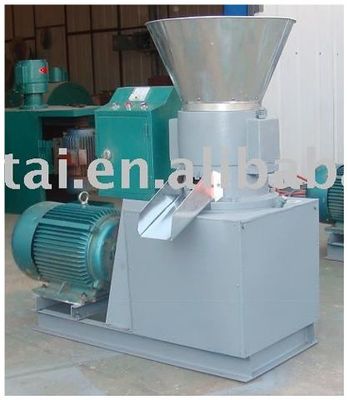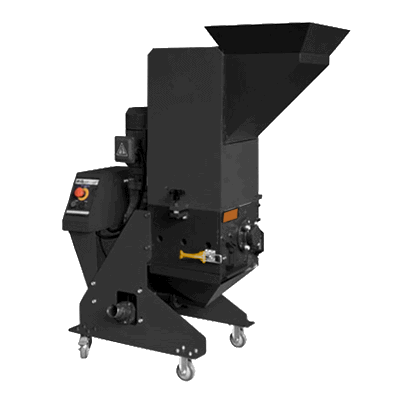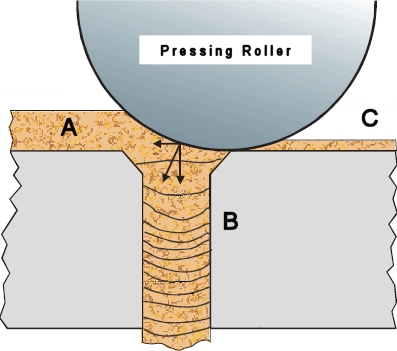Pelletized biomass: Difference between revisions
(Created page with ''''http://en.wikipedia.org/wiki/Pelletizing Pelletized http://en.wikipedia.org/wiki/Biomass biomass''' is ... TODO: expand this article ==See Also== * [http://www.bioma…') |
(Added an Internal Link) |
||
| (6 intermediate revisions by 3 users not shown) | |||
| Line 1: | Line 1: | ||
[[File:WoodPellets01.jpg|500px|thumb|right|Wood pellets are the most common type of pellet fuel and are generally made from compacted sawdust and related industrial wastes from the milling of lumber, manufacture of wood products and furniture, and construction.]] | |||
Biomass can be [https://en.wikipedia.org/wiki/Pellet_fuel pellitized] by first passing it through a [[Hammer Mill]] for uniformity, then feeding it to a press that has holes of uniform size. In this process, there is a marked increase in temperature, causing the lignin to plastify. General categories of biomass pellets include: industrial waste and co-products, food waste, agricultural residues, energy crops, and virgin lumber. Wood pellets are the most common type of pellet fuel and are generally made from compacted sawdust. | |||
The regular geometry and small size of fuel pellets allow automatic feeding with very fine calibration. They can be fed to a burner by auger feeding or by pneumatic conveying. Their high density also permits compact storage and transport over long distance. | |||
==Torrefaction== | |||
Calorific value can be greatly increased by [https://en.wikipedia.org/wiki/Torrefaction torrefaction]. Benefits are: higher energy density, more homogeneous composition, hydrophobic behavior, elimination of biological activity, improved grindability. | |||
==Elsewhere on the OSE Wiki== | |||
* [[Pelletizer]], [[Pelletizer/Research Development]], [[Pelletizer Log]], [[Nick on the Pelletizer]] | |||
* [[Biomass to Fuel]], [[Biofuel]], [[Wood Chips]], [[Gasifier]] | |||
* [[Wood Pellets]] | |||
==See Also== | ==See Also== | ||
* [http://www.biomassmagazine.com/article.jsp?article_id=2465 The Art of Biomass Pelletizing] | * Wikipedia: [https://en.wikipedia.org/wiki/Pellet_fuel Pellet fuel] and [http://en.wikipedia.org/wiki/Pelletizing Pelletizing in general] | ||
* Wikipedia: [http://en.wikipedia.org/wiki/Torrefaction Torrefaction] | |||
* Biomass Magazine: [http://www.biomassmagazine.com/article.jsp?article_id=2465 "The Art of Biomass Pelletizing"] | |||
==Image Gallery== | |||
<div align="left"><gallery widths="400px" heights="400px"> | |||
File:Sawdust.jpg|Sawdust from [[Sawmill]] | |||
File:WoodPellets.jpg|Wood Pellets | |||
File:GrassPellet.jpg|Grass Pellets | |||
File:Pelletizer.jpg|Wood Pelletizer | |||
File:Pelletizer.png|GVCS Pelletizer Mockup | |||
File:rollerdie.jpg|Roller die | |||
</gallery></div> | |||
[[Category:Biofuel]] | |||
[[Category:Pelletizer]] | |||
[[Category:Farm equipment]] | |||
Latest revision as of 00:49, 15 August 2024
Biomass can be pellitized by first passing it through a Hammer Mill for uniformity, then feeding it to a press that has holes of uniform size. In this process, there is a marked increase in temperature, causing the lignin to plastify. General categories of biomass pellets include: industrial waste and co-products, food waste, agricultural residues, energy crops, and virgin lumber. Wood pellets are the most common type of pellet fuel and are generally made from compacted sawdust.
The regular geometry and small size of fuel pellets allow automatic feeding with very fine calibration. They can be fed to a burner by auger feeding or by pneumatic conveying. Their high density also permits compact storage and transport over long distance.
Torrefaction
Calorific value can be greatly increased by torrefaction. Benefits are: higher energy density, more homogeneous composition, hydrophobic behavior, elimination of biological activity, improved grindability.
Elsewhere on the OSE Wiki
- Pelletizer, Pelletizer/Research Development, Pelletizer Log, Nick on the Pelletizer
- Biomass to Fuel, Biofuel, Wood Chips, Gasifier
- Wood Pellets
See Also
- Wikipedia: Pellet fuel and Pelletizing in general
- Wikipedia: Torrefaction
- Biomass Magazine: "The Art of Biomass Pelletizing"
Image Gallery
Sawdust from Sawmill
